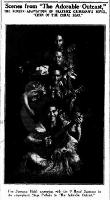 7033926785135101841.jpg
7033926785135101841.jpg
Promotional image, Townsville Daily Bulletin, 3 August 1928, p.11 (via Trove Australia)
Alternative title:
Black Cargoes of the South Seas
Adaptation of
Conn of the Coral Seas
1922
single work
novel
Issue Details:
First known date:
1928...
1928
The Adorable Outcast


